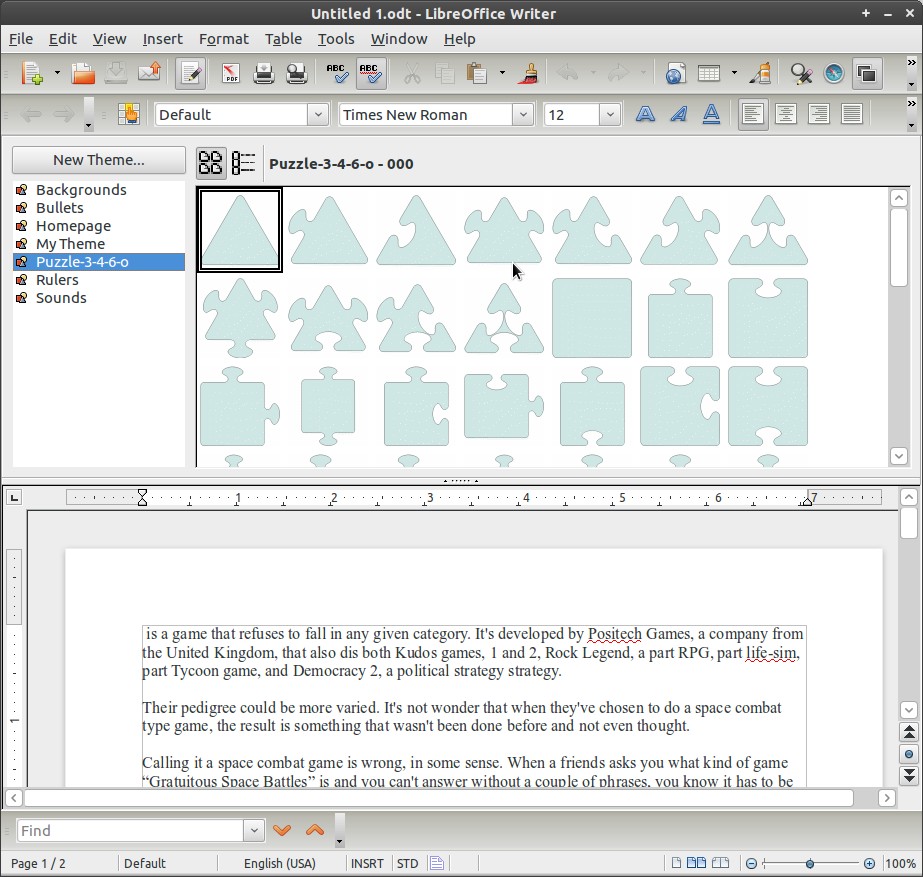odt2daisy extension supports Mathematical Markup Language (MathML) and multilingual documents. It uses the text-to-speech engines installed in the user's operating system for speech synthesis.
Preparing Documents for Conversion to DAISY
In order to export usable DAISY books, the text document that is used as a source must be reasonably accessible. OpenDocument Text (ODT) files must at least fulfil the following criteria:
The document's default language must be correctly identified.
Any language changes inside the document must be correctly identified.
Images must be in either PNG or JPEG format; other formats are not supported by DAISY.
Headings must use correct styles: Heading 1, Heading 2, etcetera, instead of big bold text.
Images and other non-text objects must have a text alternative. To provide a text alternative for an object, right-click on the object, select Description, and fill in the Title field. For complex images, also add a detailed description in the Description field.
For more detailed accessibility techniques, please consult the guidelines provided by the Accessible Digital Office Document (ADOD) Project at adod.idrc.ocad.ca.
Using odt2daisy
To create a Full DAISY book (a book with both text and sound), select "Export as Full DAISY" in the File menu, or the corresponding button on the Standard toolbar. odt2daisy will prompt for a location and file name. In the next step, odt2daisy prompts for metadata (see screenshot):
UID is a unique identifier generated by odt2daisy;
the Title field is copied from the Document Properties (or the first Title style if the Title field in the Document Properties is empty),
the Creator field is copied from the author metadata in the ODT file,
the Publisher field refers to the publisher of the DAISY book and is only relevant to organisations that publish DAISY books,
the Producer field refers to the organisation that produced the DAISY book, typically on behalf of the publisher,
the Language field is automatically generated from metadata in the ODT file,
"Use alternative level markup" should be checked if the ODT file uses more than 6 levels of headings,
"Include page numbers" includes the page numbering of the ODT file in the DAISY book, in order to help users of the DAISY version navigate to the same pages as users of a printed version of the same document,
"Include CSS" can be checked when the DAISY XML code will be viewed in a web browser,
Bitrate uses a default value of 32 kbit/s, which is sufficient for synthetic speech,
"Apply fix routines to DAISY book" enables some obvious structural fixes to make sure that the DAISY book plays in all DAISY players,
"Apply sentence detection" should be checked when the DAISY book will be played in a DAISY player that supports synchronous highlighting of the text that is being spoken.
After pressing Export, the conversion will start. Part of the conversion process is handled by the DAISY Pipeline Lite, which displays a completion dialog when the conversion has ended.
In order to play the DAISY book, open the speechgen.opf file in the z3986 folder; this will play the DAISY 3.0 version. The DAISY 2.02 version in the daisy202 folder is provided for compatibility with older DAISY players.
In order to export only DAISY XML instead of Full DAISY, select "Export as DAISY XML" in the File menu, or the corresponding button on the Standard toolbar. odt2daisy will prompt for a location and file name. In the next step, odt2daisy will prompt for the same metadata as in the Full DAISY export process, but the options related to speech synthesis (bitrate, fix routines and sentence detection) will be omitted. odt2daisy will then directly export DAISY 3.0 XML, without using the DAISY Pipeline Lite.
Requirements:
- LibreOffice


Comments not found